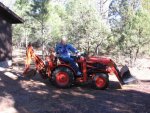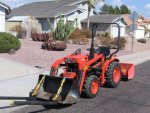While a lot of operators may know the dangers of back-dragging, there are many that do not, so I’m hoping this may help prevent expensive damage and repairs.
The issue with back dragging comes when you have the bucket vertical or even pointed back towards the tires. If you look at the mechanics of the curl function you will see that any pressure on the bottom edge of your bucket is transferred into trying to push the rod back in the cylinder. If the forces are too great the rod has nowhere to go and can easily bend. This damage usually happens when driving backwards too fast or if the bucket catches something immovable. The problem is common upon all brands and sizes of equipment.
While the following story is not technically back dragging, I did damage my tractor and bent a curl cylinder by trying to spin a tree that was cut. I was using forks, put them on the far side of the tree, backed up, and bam, a bent curl cylinder. I wasn’t backing up fast, I didn’t have to force it, yet it still bent.
The issue with back dragging comes when you have the bucket vertical or even pointed back towards the tires. If you look at the mechanics of the curl function you will see that any pressure on the bottom edge of your bucket is transferred into trying to push the rod back in the cylinder. If the forces are too great the rod has nowhere to go and can easily bend. This damage usually happens when driving backwards too fast or if the bucket catches something immovable. The problem is common upon all brands and sizes of equipment.
While the following story is not technically back dragging, I did damage my tractor and bent a curl cylinder by trying to spin a tree that was cut. I was using forks, put them on the far side of the tree, backed up, and bam, a bent curl cylinder. I wasn’t backing up fast, I didn’t have to force it, yet it still bent.
Last edited:



